Biomarkers & LDL: Exploring Relationships & Health Impacts Study
VerifiedAdded on 2023/06/11
|10
|1903
|350
Report
AI Summary
This report investigates the relationship between low-density lipoprotein (LDL) and various biomarkers, including age, pulse rate, systolic and diastolic blood pressure, BMI, and gender. The analysis includes summary statistics, correlation analysis, paired sample t-tests, ANOVA, and regression modeling. The findings indicate a moderate relationship between age and LDL, a significant difference in diastolic blood pressure and pulse rate between genders, and a statistically significant relationship between the biomarkers and LDL levels. The regression analysis suggests that fluctuations in the independent variables (biomarkers) can impact LDL levels. The report concludes that individual health is directly affected by BMI, blood pressure, and cholesterol, highlighting the importance of understanding these relationships for health management. Desklib provides access to this and other solved assignments for student learning.
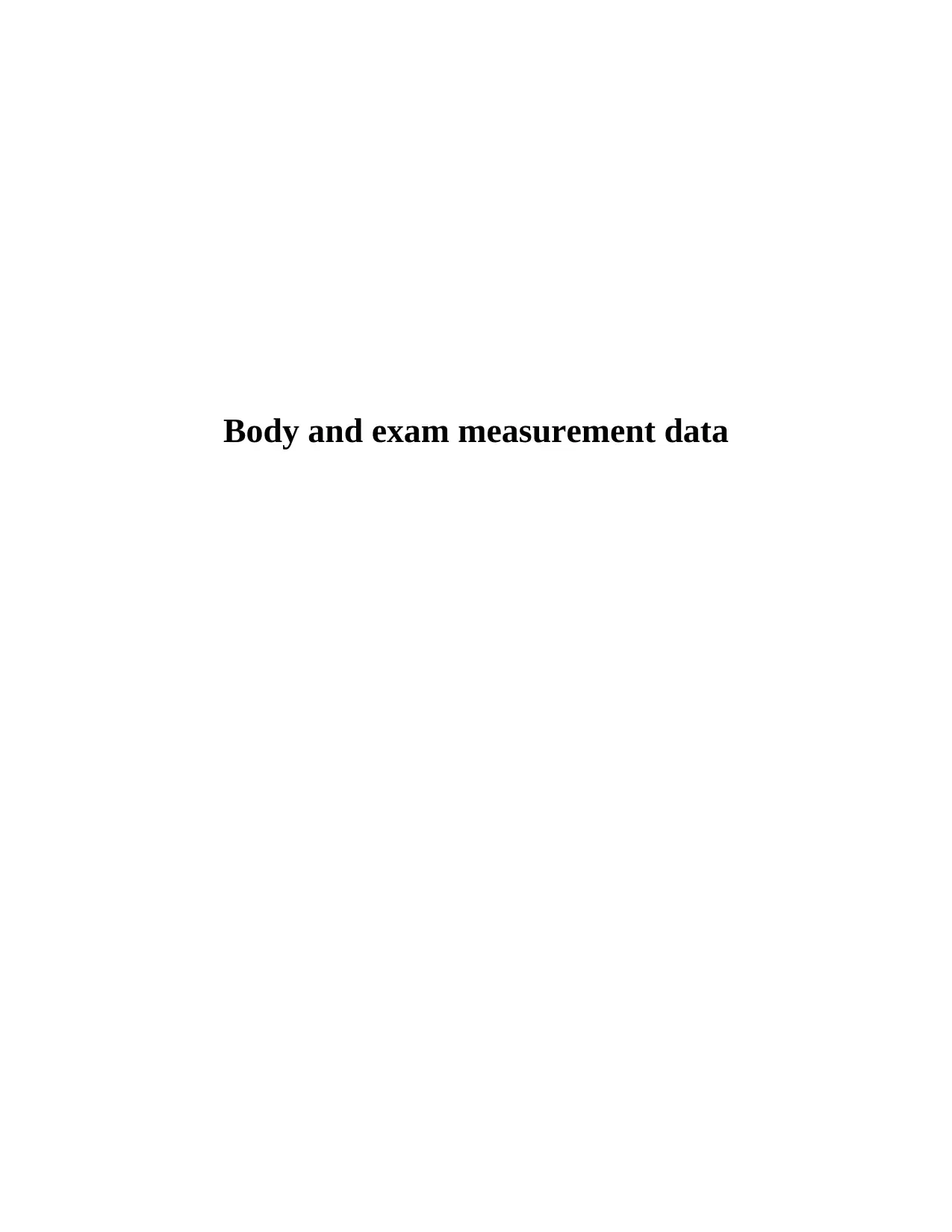
Body and exam measurement data
Paraphrase This Document
Need a fresh take? Get an instant paraphrase of this document with our AI Paraphraser
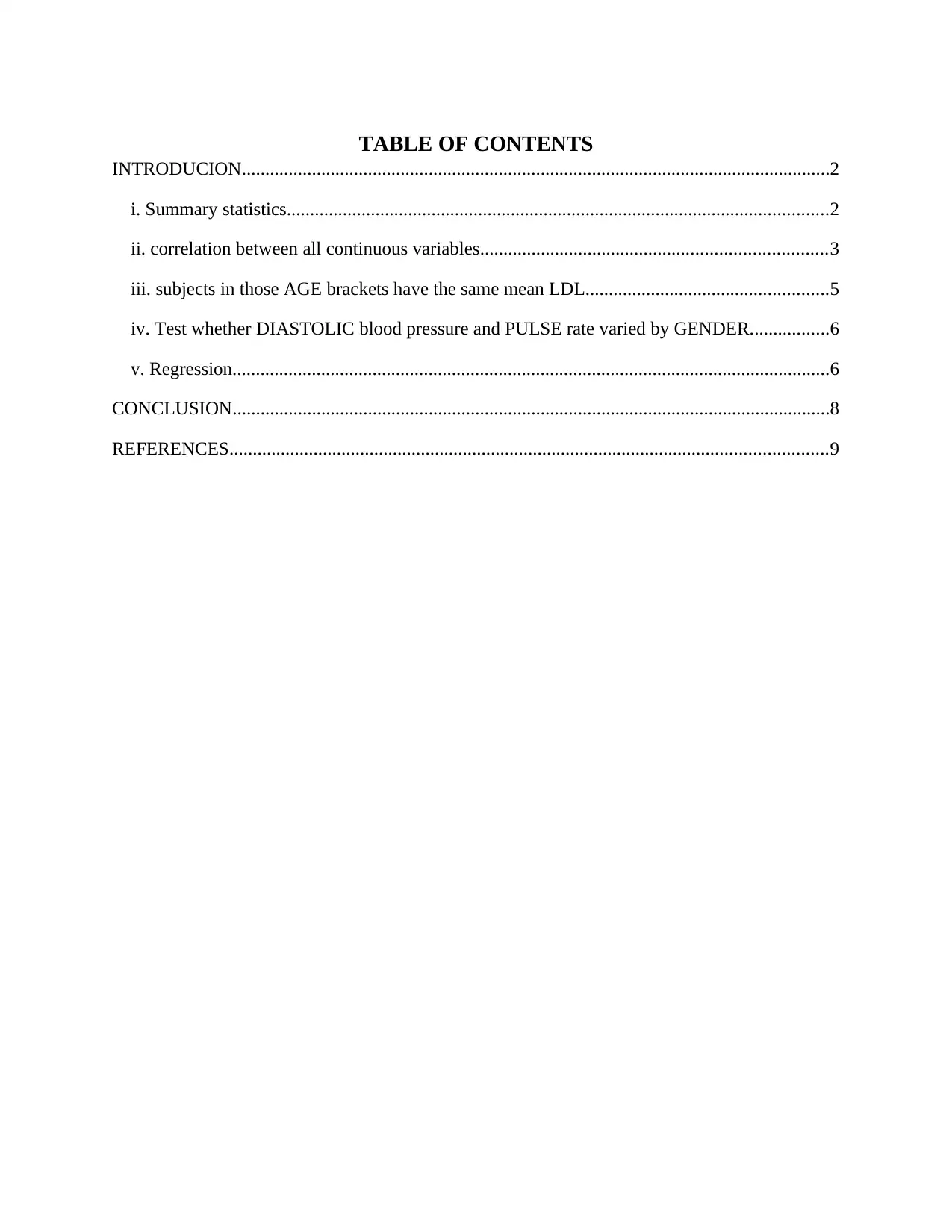
TABLE OF CONTENTS
INTRODUCION..............................................................................................................................2
i. Summary statistics....................................................................................................................2
ii. correlation between all continuous variables..........................................................................3
iii. subjects in those AGE brackets have the same mean LDL....................................................5
iv. Test whether DIASTOLIC blood pressure and PULSE rate varied by GENDER.................6
v. Regression................................................................................................................................6
CONCLUSION................................................................................................................................8
REFERENCES................................................................................................................................9
INTRODUCION..............................................................................................................................2
i. Summary statistics....................................................................................................................2
ii. correlation between all continuous variables..........................................................................3
iii. subjects in those AGE brackets have the same mean LDL....................................................5
iv. Test whether DIASTOLIC blood pressure and PULSE rate varied by GENDER.................6
v. Regression................................................................................................................................6
CONCLUSION................................................................................................................................8
REFERENCES................................................................................................................................9

Title: To determine the relationship between low density Lipoprotein and some
biomarkers.
INTRODUCION
In the recent times, individual faces issue due to their cholesterol, high BP and this in turn
affect their performance. That is why, the present study will help to develop a deep
understanding pertaining to the biomarkers that create a direct impact over the health. For that
different test has been applied which in turn assist to create a better outcome and reflect about
the relationship between the variables.
i. Summary statistics
Statistics
pulse rate diastolic
blood
pressure
Low-Density
Lipoprotein
BMI Gender
N Valid 80 80 80 80 80
Missing 0 0 0 0 0
Mean 72.38 68.10 117.23 27.5206 .50
Median 72.00 70.00 113.50 26.5300 .50
Mode 72a 76 77a 20.37a 0a
Std. Deviation 12.051 13.587 37.437 6.48286 .503
Skewness .422 -1.838 .516 .828 .000
Std. Error of
Skewness .269 .269 .269 .269 .269
Kurtosis .042 7.137 .068 .566 -2.052
Std. Error of Kurtosis .532 .532 .532 .532 .532
a. Multiple modes exist. The smallest value is shown
Interpretation: Through the above table, it has been identified that average number of
respondents have the 72.38 beats per minute. Also, majority of the selected respondents have 76
diastolic blood pressure and 50% of the selected respondents have 70 mm Hg diastolic blood
pressure. Further, average selected participants have 117.23 mg / DL as a Low-Density
Lipoprotein (LDL) cholesterol whereas it might be fluctuate with 113.50 (standard deviation).
Apart from this, there are equal number of male and female and that is why, there is no
biomarkers.
INTRODUCION
In the recent times, individual faces issue due to their cholesterol, high BP and this in turn
affect their performance. That is why, the present study will help to develop a deep
understanding pertaining to the biomarkers that create a direct impact over the health. For that
different test has been applied which in turn assist to create a better outcome and reflect about
the relationship between the variables.
i. Summary statistics
Statistics
pulse rate diastolic
blood
pressure
Low-Density
Lipoprotein
BMI Gender
N Valid 80 80 80 80 80
Missing 0 0 0 0 0
Mean 72.38 68.10 117.23 27.5206 .50
Median 72.00 70.00 113.50 26.5300 .50
Mode 72a 76 77a 20.37a 0a
Std. Deviation 12.051 13.587 37.437 6.48286 .503
Skewness .422 -1.838 .516 .828 .000
Std. Error of
Skewness .269 .269 .269 .269 .269
Kurtosis .042 7.137 .068 .566 -2.052
Std. Error of Kurtosis .532 .532 .532 .532 .532
a. Multiple modes exist. The smallest value is shown
Interpretation: Through the above table, it has been identified that average number of
respondents have the 72.38 beats per minute. Also, majority of the selected respondents have 76
diastolic blood pressure and 50% of the selected respondents have 70 mm Hg diastolic blood
pressure. Further, average selected participants have 117.23 mg / DL as a Low-Density
Lipoprotein (LDL) cholesterol whereas it might be fluctuate with 113.50 (standard deviation).
Apart from this, there are equal number of male and female and that is why, there is no
⊘ This is a preview!⊘
Do you want full access?
Subscribe today to unlock all pages.

Trusted by 1+ million students worldwide
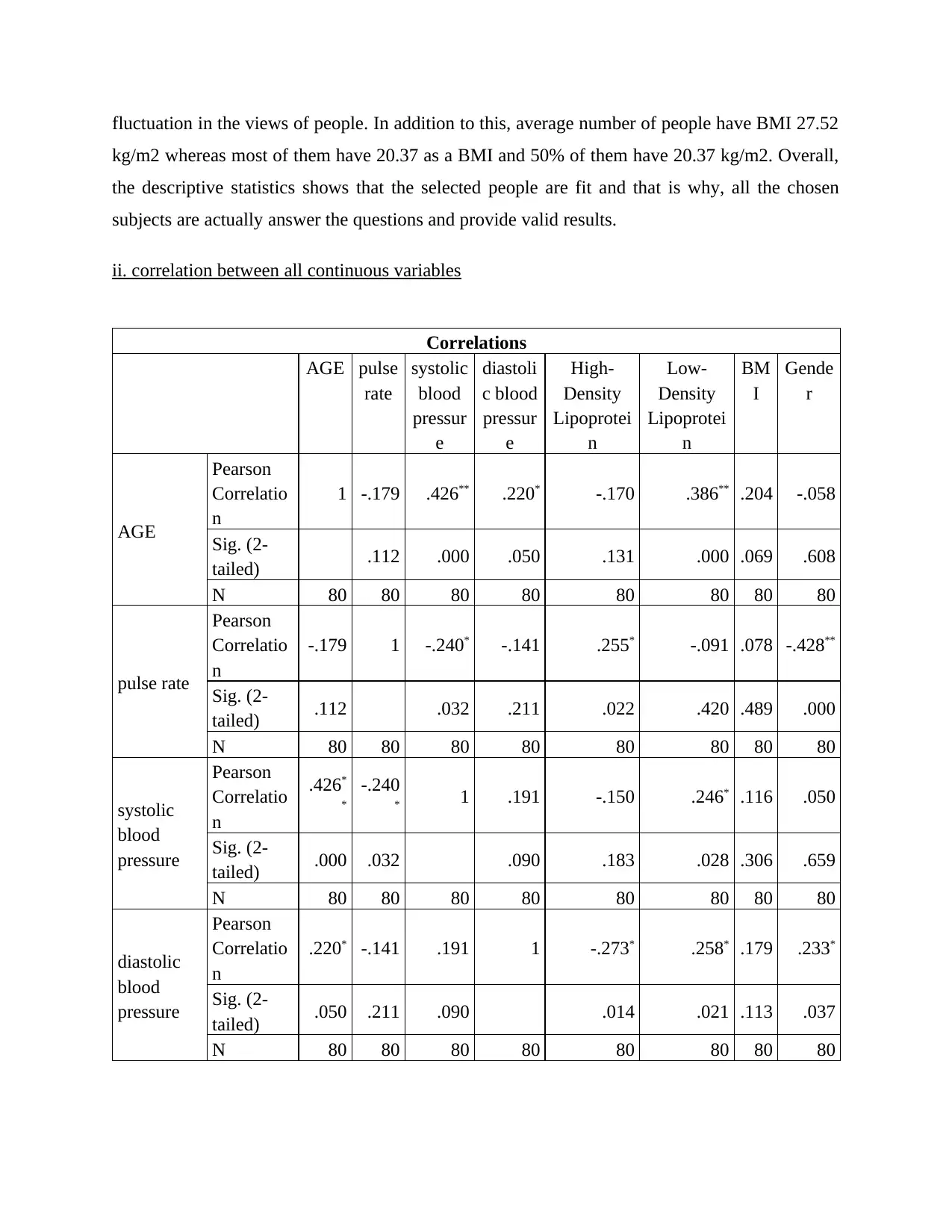
fluctuation in the views of people. In addition to this, average number of people have BMI 27.52
kg/m2 whereas most of them have 20.37 as a BMI and 50% of them have 20.37 kg/m2. Overall,
the descriptive statistics shows that the selected people are fit and that is why, all the chosen
subjects are actually answer the questions and provide valid results.
ii. correlation between all continuous variables
Correlations
AGE pulse
rate
systolic
blood
pressur
e
diastoli
c blood
pressur
e
High-
Density
Lipoprotei
n
Low-
Density
Lipoprotei
n
BM
I
Gende
r
AGE
Pearson
Correlatio
n
1 -.179 .426** .220* -.170 .386** .204 -.058
Sig. (2-
tailed) .112 .000 .050 .131 .000 .069 .608
N 80 80 80 80 80 80 80 80
pulse rate
Pearson
Correlatio
n
-.179 1 -.240* -.141 .255* -.091 .078 -.428**
Sig. (2-
tailed) .112 .032 .211 .022 .420 .489 .000
N 80 80 80 80 80 80 80 80
systolic
blood
pressure
Pearson
Correlatio
n
.426*
*
-.240
* 1 .191 -.150 .246* .116 .050
Sig. (2-
tailed) .000 .032 .090 .183 .028 .306 .659
N 80 80 80 80 80 80 80 80
diastolic
blood
pressure
Pearson
Correlatio
n
.220* -.141 .191 1 -.273* .258* .179 .233*
Sig. (2-
tailed) .050 .211 .090 .014 .021 .113 .037
N 80 80 80 80 80 80 80 80
kg/m2 whereas most of them have 20.37 as a BMI and 50% of them have 20.37 kg/m2. Overall,
the descriptive statistics shows that the selected people are fit and that is why, all the chosen
subjects are actually answer the questions and provide valid results.
ii. correlation between all continuous variables
Correlations
AGE pulse
rate
systolic
blood
pressur
e
diastoli
c blood
pressur
e
High-
Density
Lipoprotei
n
Low-
Density
Lipoprotei
n
BM
I
Gende
r
AGE
Pearson
Correlatio
n
1 -.179 .426** .220* -.170 .386** .204 -.058
Sig. (2-
tailed) .112 .000 .050 .131 .000 .069 .608
N 80 80 80 80 80 80 80 80
pulse rate
Pearson
Correlatio
n
-.179 1 -.240* -.141 .255* -.091 .078 -.428**
Sig. (2-
tailed) .112 .032 .211 .022 .420 .489 .000
N 80 80 80 80 80 80 80 80
systolic
blood
pressure
Pearson
Correlatio
n
.426*
*
-.240
* 1 .191 -.150 .246* .116 .050
Sig. (2-
tailed) .000 .032 .090 .183 .028 .306 .659
N 80 80 80 80 80 80 80 80
diastolic
blood
pressure
Pearson
Correlatio
n
.220* -.141 .191 1 -.273* .258* .179 .233*
Sig. (2-
tailed) .050 .211 .090 .014 .021 .113 .037
N 80 80 80 80 80 80 80 80
Paraphrase This Document
Need a fresh take? Get an instant paraphrase of this document with our AI Paraphraser

High-
Density
Lipoprotei
n
Pearson
Correlatio
n
-.170 .255* -.150 -.273* 1 -.245* -.14
2 -.233*
Sig. (2-
tailed) .131 .022 .183 .014 .029 .209 .038
N 80 80 80 80 80 80 80 80
Low-
Density
Lipoprotei
n
Pearson
Correlatio
n
.386*
* -.091 .246* .258* -.245* 1 .106 .122
Sig. (2-
tailed) .000 .420 .028 .021 .029 .348 .282
N 80 80 80 80 80 80 80 80
BMI
Pearson
Correlatio
n
.204 .078 .116 .179 -.142 .106 1 -.143
Sig. (2-
tailed) .069 .489 .306 .113 .209 .348 .206
N 80 80 80 80 80 80 80 80
Gender
Pearson
Correlatio
n
-.058 -.428
** .050 .233* -.233* .122 -.14
3 1
Sig. (2-
tailed) .608 .000 .659 .037 .038 .282 .206
N 80 80 80 80 80 80 80 80
**. Correlation is significant at the 0.01 level (2-tailed).
*. Correlation is significant at the 0.05 level (2-tailed).
Interpretation: In accordance with the correlation table, it can be identified that there is
negative low relationship between age and pulse rate whereas systolic blood pressure, Low
density lipoprotein and age have moderate relationship because the value 0.42, 0.38 is fall
between 0.25 to 0.50. Further, lower relationship identified within diastolic blood pressure, BMI
and Age while high density Lipoprotein have negative relationship with age.
Through the above table, it has been identified that there is negative lower relationship
between pulse rate and systolic blood pressure, diastolic blood pressure, low density lipoprotein,
gender because the values are negative and less than -0.50. Further, low relationship identified
within high density lipoprotein and BMI with pulse rate which in turn shows that there is minor
Density
Lipoprotei
n
Pearson
Correlatio
n
-.170 .255* -.150 -.273* 1 -.245* -.14
2 -.233*
Sig. (2-
tailed) .131 .022 .183 .014 .029 .209 .038
N 80 80 80 80 80 80 80 80
Low-
Density
Lipoprotei
n
Pearson
Correlatio
n
.386*
* -.091 .246* .258* -.245* 1 .106 .122
Sig. (2-
tailed) .000 .420 .028 .021 .029 .348 .282
N 80 80 80 80 80 80 80 80
BMI
Pearson
Correlatio
n
.204 .078 .116 .179 -.142 .106 1 -.143
Sig. (2-
tailed) .069 .489 .306 .113 .209 .348 .206
N 80 80 80 80 80 80 80 80
Gender
Pearson
Correlatio
n
-.058 -.428
** .050 .233* -.233* .122 -.14
3 1
Sig. (2-
tailed) .608 .000 .659 .037 .038 .282 .206
N 80 80 80 80 80 80 80 80
**. Correlation is significant at the 0.01 level (2-tailed).
*. Correlation is significant at the 0.05 level (2-tailed).
Interpretation: In accordance with the correlation table, it can be identified that there is
negative low relationship between age and pulse rate whereas systolic blood pressure, Low
density lipoprotein and age have moderate relationship because the value 0.42, 0.38 is fall
between 0.25 to 0.50. Further, lower relationship identified within diastolic blood pressure, BMI
and Age while high density Lipoprotein have negative relationship with age.
Through the above table, it has been identified that there is negative lower relationship
between pulse rate and systolic blood pressure, diastolic blood pressure, low density lipoprotein,
gender because the values are negative and less than -0.50. Further, low relationship identified
within high density lipoprotein and BMI with pulse rate which in turn shows that there is minor
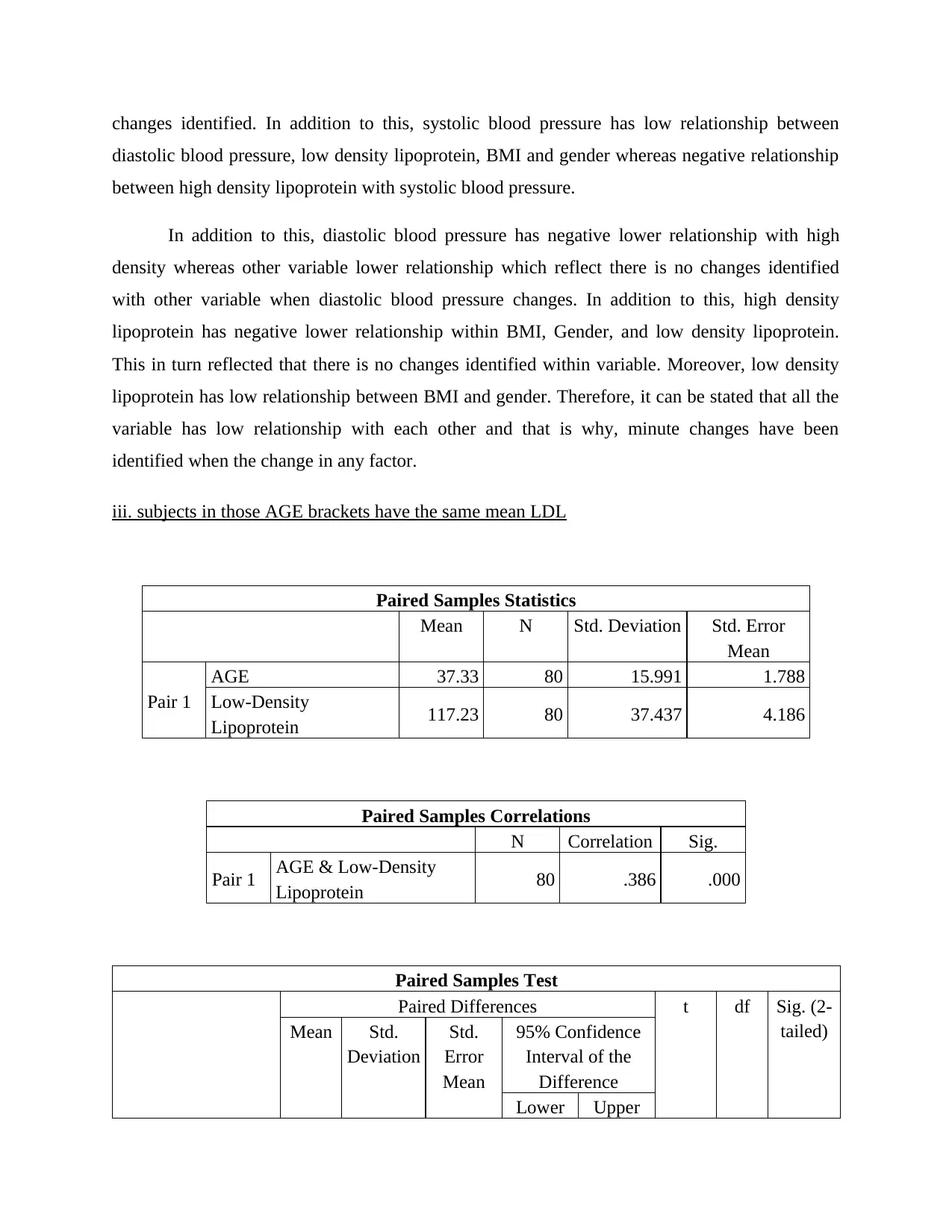
changes identified. In addition to this, systolic blood pressure has low relationship between
diastolic blood pressure, low density lipoprotein, BMI and gender whereas negative relationship
between high density lipoprotein with systolic blood pressure.
In addition to this, diastolic blood pressure has negative lower relationship with high
density whereas other variable lower relationship which reflect there is no changes identified
with other variable when diastolic blood pressure changes. In addition to this, high density
lipoprotein has negative lower relationship within BMI, Gender, and low density lipoprotein.
This in turn reflected that there is no changes identified within variable. Moreover, low density
lipoprotein has low relationship between BMI and gender. Therefore, it can be stated that all the
variable has low relationship with each other and that is why, minute changes have been
identified when the change in any factor.
iii. subjects in those AGE brackets have the same mean LDL
Paired Samples Statistics
Mean N Std. Deviation Std. Error
Mean
Pair 1
AGE 37.33 80 15.991 1.788
Low-Density
Lipoprotein 117.23 80 37.437 4.186
Paired Samples Correlations
N Correlation Sig.
Pair 1 AGE & Low-Density
Lipoprotein 80 .386 .000
Paired Samples Test
Paired Differences t df Sig. (2-
tailed)Mean Std.
Deviation
Std.
Error
Mean
95% Confidence
Interval of the
Difference
Lower Upper
diastolic blood pressure, low density lipoprotein, BMI and gender whereas negative relationship
between high density lipoprotein with systolic blood pressure.
In addition to this, diastolic blood pressure has negative lower relationship with high
density whereas other variable lower relationship which reflect there is no changes identified
with other variable when diastolic blood pressure changes. In addition to this, high density
lipoprotein has negative lower relationship within BMI, Gender, and low density lipoprotein.
This in turn reflected that there is no changes identified within variable. Moreover, low density
lipoprotein has low relationship between BMI and gender. Therefore, it can be stated that all the
variable has low relationship with each other and that is why, minute changes have been
identified when the change in any factor.
iii. subjects in those AGE brackets have the same mean LDL
Paired Samples Statistics
Mean N Std. Deviation Std. Error
Mean
Pair 1
AGE 37.33 80 15.991 1.788
Low-Density
Lipoprotein 117.23 80 37.437 4.186
Paired Samples Correlations
N Correlation Sig.
Pair 1 AGE & Low-Density
Lipoprotein 80 .386 .000
Paired Samples Test
Paired Differences t df Sig. (2-
tailed)Mean Std.
Deviation
Std.
Error
Mean
95% Confidence
Interval of the
Difference
Lower Upper
⊘ This is a preview!⊘
Do you want full access?
Subscribe today to unlock all pages.

Trusted by 1+ million students worldwide

Pair
1
AGE - Low-
Density
Lipoprotein
-
79.900 34.564 3.864 -87.592 -72.208 -
20.676 79 .000
Interpretation: In accordance with the paired sample t test, it has been identified that
null hypothesis is rejected from other because the significance difference between the value is
lower than standard criteria. However, there is a moderate relationship between age and low
density Lipoprotein which in turn reflected that when age of people changes, it create a direct
impact over the low density lipoprotein (Coşkun and et.al., 2021).
iv. Test whether DIASTOLIC blood pressure and PULSE rate varied by GENDER.
Null hypothesis: There is no significance difference between the mean group of diastolic blood
pressure, pulse rate within gender.
Alternative hypothesis: There is a significance difference between the mean group of diastolic
blood pressure, pulse rate within gender.
ANOVA
Sum of
Squares
df Mean Square F Sig.
pulse rate
Between Groups 2101.250 1 2101.250 17.489 .000
Within Groups 9371.500 78 120.147
Total 11472.750 79
diastolic blood
pressure
Between Groups 793.800 1 793.800 4.490 .037
Within Groups 13789.400 78 176.787
Total 14583.200 79
Interpretation: By applying one way anova, it has been identified that alternative
hypothesis is accepted because the value of p is lower than 0.05 and it can be stated that there is
a difference between the mean group of diastolic blood pressure, pulse rate within gender.
Further, it can be stated that male have high BP problem as compared to female.
v. Regression
H0: There is no significance relationship between the biomarkers of body and Low Density
Lipoprotein.
1
AGE - Low-
Density
Lipoprotein
-
79.900 34.564 3.864 -87.592 -72.208 -
20.676 79 .000
Interpretation: In accordance with the paired sample t test, it has been identified that
null hypothesis is rejected from other because the significance difference between the value is
lower than standard criteria. However, there is a moderate relationship between age and low
density Lipoprotein which in turn reflected that when age of people changes, it create a direct
impact over the low density lipoprotein (Coşkun and et.al., 2021).
iv. Test whether DIASTOLIC blood pressure and PULSE rate varied by GENDER.
Null hypothesis: There is no significance difference between the mean group of diastolic blood
pressure, pulse rate within gender.
Alternative hypothesis: There is a significance difference between the mean group of diastolic
blood pressure, pulse rate within gender.
ANOVA
Sum of
Squares
df Mean Square F Sig.
pulse rate
Between Groups 2101.250 1 2101.250 17.489 .000
Within Groups 9371.500 78 120.147
Total 11472.750 79
diastolic blood
pressure
Between Groups 793.800 1 793.800 4.490 .037
Within Groups 13789.400 78 176.787
Total 14583.200 79
Interpretation: By applying one way anova, it has been identified that alternative
hypothesis is accepted because the value of p is lower than 0.05 and it can be stated that there is
a difference between the mean group of diastolic blood pressure, pulse rate within gender.
Further, it can be stated that male have high BP problem as compared to female.
v. Regression
H0: There is no significance relationship between the biomarkers of body and Low Density
Lipoprotein.
Paraphrase This Document
Need a fresh take? Get an instant paraphrase of this document with our AI Paraphraser
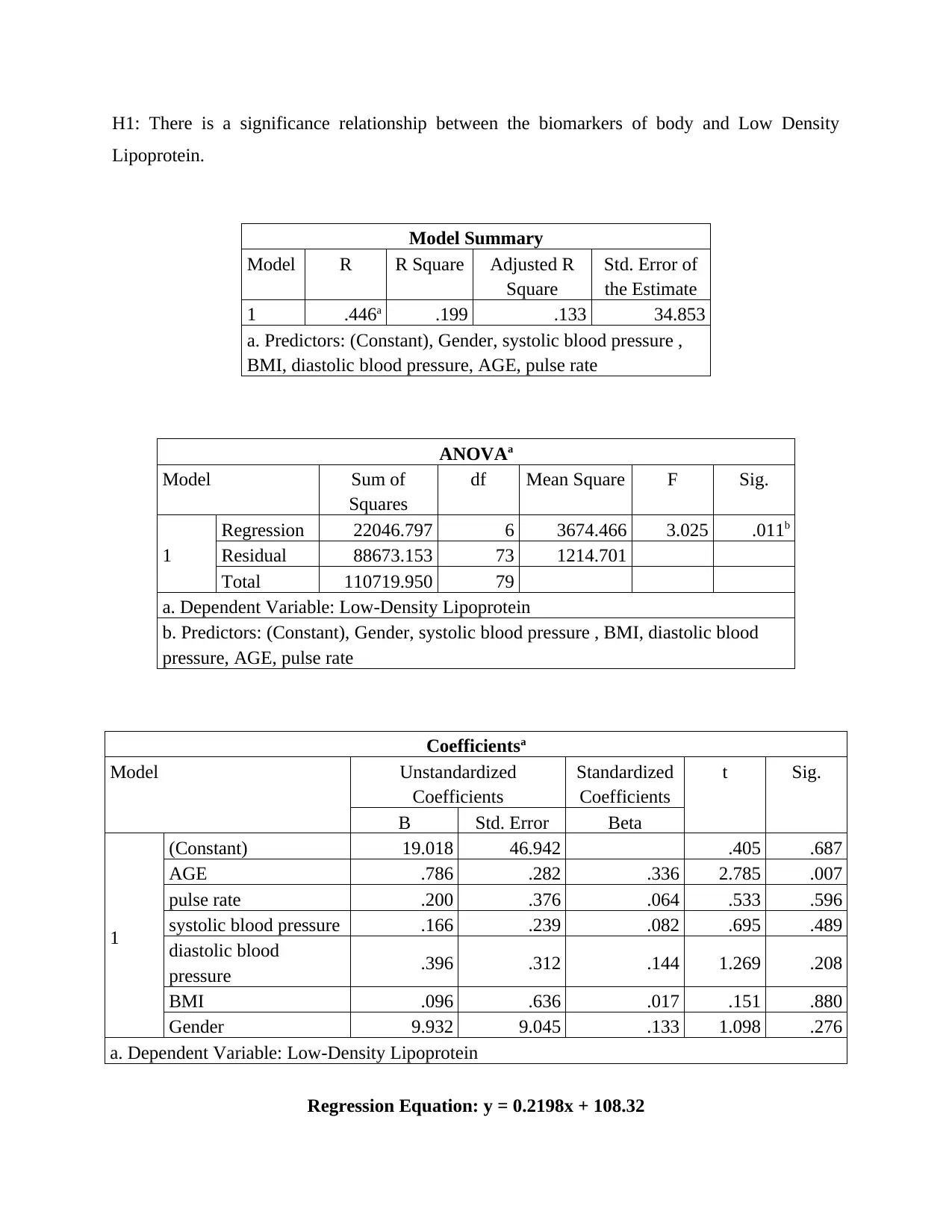
H1: There is a significance relationship between the biomarkers of body and Low Density
Lipoprotein.
Model Summary
Model R R Square Adjusted R
Square
Std. Error of
the Estimate
1 .446a .199 .133 34.853
a. Predictors: (Constant), Gender, systolic blood pressure ,
BMI, diastolic blood pressure, AGE, pulse rate
ANOVAa
Model Sum of
Squares
df Mean Square F Sig.
1
Regression 22046.797 6 3674.466 3.025 .011b
Residual 88673.153 73 1214.701
Total 110719.950 79
a. Dependent Variable: Low-Density Lipoprotein
b. Predictors: (Constant), Gender, systolic blood pressure , BMI, diastolic blood
pressure, AGE, pulse rate
Coefficientsa
Model Unstandardized
Coefficients
Standardized
Coefficients
t Sig.
B Std. Error Beta
1
(Constant) 19.018 46.942 .405 .687
AGE .786 .282 .336 2.785 .007
pulse rate .200 .376 .064 .533 .596
systolic blood pressure .166 .239 .082 .695 .489
diastolic blood
pressure .396 .312 .144 1.269 .208
BMI .096 .636 .017 .151 .880
Gender 9.932 9.045 .133 1.098 .276
a. Dependent Variable: Low-Density Lipoprotein
Regression Equation: y = 0.2198x + 108.32
Lipoprotein.
Model Summary
Model R R Square Adjusted R
Square
Std. Error of
the Estimate
1 .446a .199 .133 34.853
a. Predictors: (Constant), Gender, systolic blood pressure ,
BMI, diastolic blood pressure, AGE, pulse rate
ANOVAa
Model Sum of
Squares
df Mean Square F Sig.
1
Regression 22046.797 6 3674.466 3.025 .011b
Residual 88673.153 73 1214.701
Total 110719.950 79
a. Dependent Variable: Low-Density Lipoprotein
b. Predictors: (Constant), Gender, systolic blood pressure , BMI, diastolic blood
pressure, AGE, pulse rate
Coefficientsa
Model Unstandardized
Coefficients
Standardized
Coefficients
t Sig.
B Std. Error Beta
1
(Constant) 19.018 46.942 .405 .687
AGE .786 .282 .336 2.785 .007
pulse rate .200 .376 .064 .533 .596
systolic blood pressure .166 .239 .082 .695 .489
diastolic blood
pressure .396 .312 .144 1.269 .208
BMI .096 .636 .017 .151 .880
Gender 9.932 9.045 .133 1.098 .276
a. Dependent Variable: Low-Density Lipoprotein
Regression Equation: y = 0.2198x + 108.32
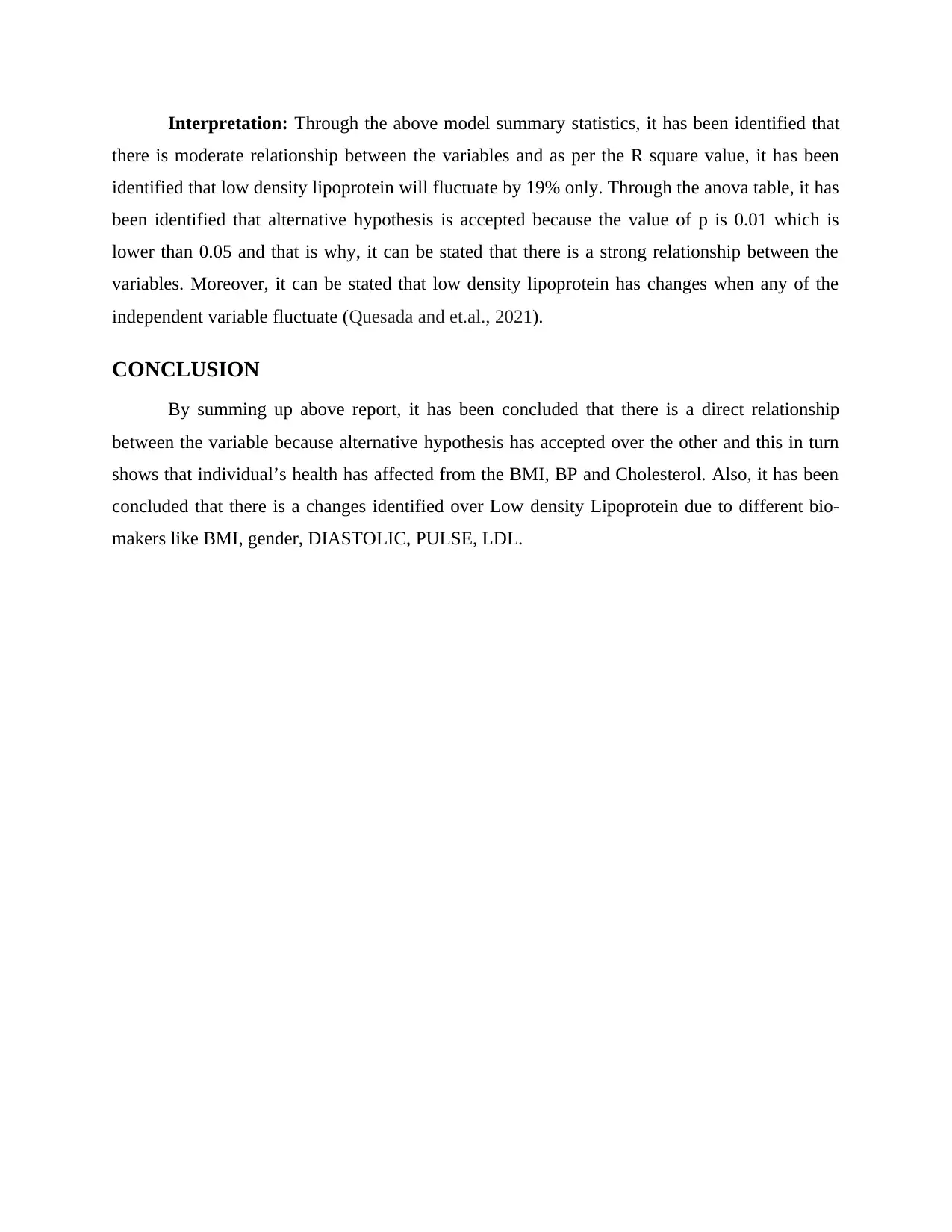
Interpretation: Through the above model summary statistics, it has been identified that
there is moderate relationship between the variables and as per the R square value, it has been
identified that low density lipoprotein will fluctuate by 19% only. Through the anova table, it has
been identified that alternative hypothesis is accepted because the value of p is 0.01 which is
lower than 0.05 and that is why, it can be stated that there is a strong relationship between the
variables. Moreover, it can be stated that low density lipoprotein has changes when any of the
independent variable fluctuate (Quesada and et.al., 2021).
CONCLUSION
By summing up above report, it has been concluded that there is a direct relationship
between the variable because alternative hypothesis has accepted over the other and this in turn
shows that individual’s health has affected from the BMI, BP and Cholesterol. Also, it has been
concluded that there is a changes identified over Low density Lipoprotein due to different bio-
makers like BMI, gender, DIASTOLIC, PULSE, LDL.
there is moderate relationship between the variables and as per the R square value, it has been
identified that low density lipoprotein will fluctuate by 19% only. Through the anova table, it has
been identified that alternative hypothesis is accepted because the value of p is 0.01 which is
lower than 0.05 and that is why, it can be stated that there is a strong relationship between the
variables. Moreover, it can be stated that low density lipoprotein has changes when any of the
independent variable fluctuate (Quesada and et.al., 2021).
CONCLUSION
By summing up above report, it has been concluded that there is a direct relationship
between the variable because alternative hypothesis has accepted over the other and this in turn
shows that individual’s health has affected from the BMI, BP and Cholesterol. Also, it has been
concluded that there is a changes identified over Low density Lipoprotein due to different bio-
makers like BMI, gender, DIASTOLIC, PULSE, LDL.
⊘ This is a preview!⊘
Do you want full access?
Subscribe today to unlock all pages.

Trusted by 1+ million students worldwide
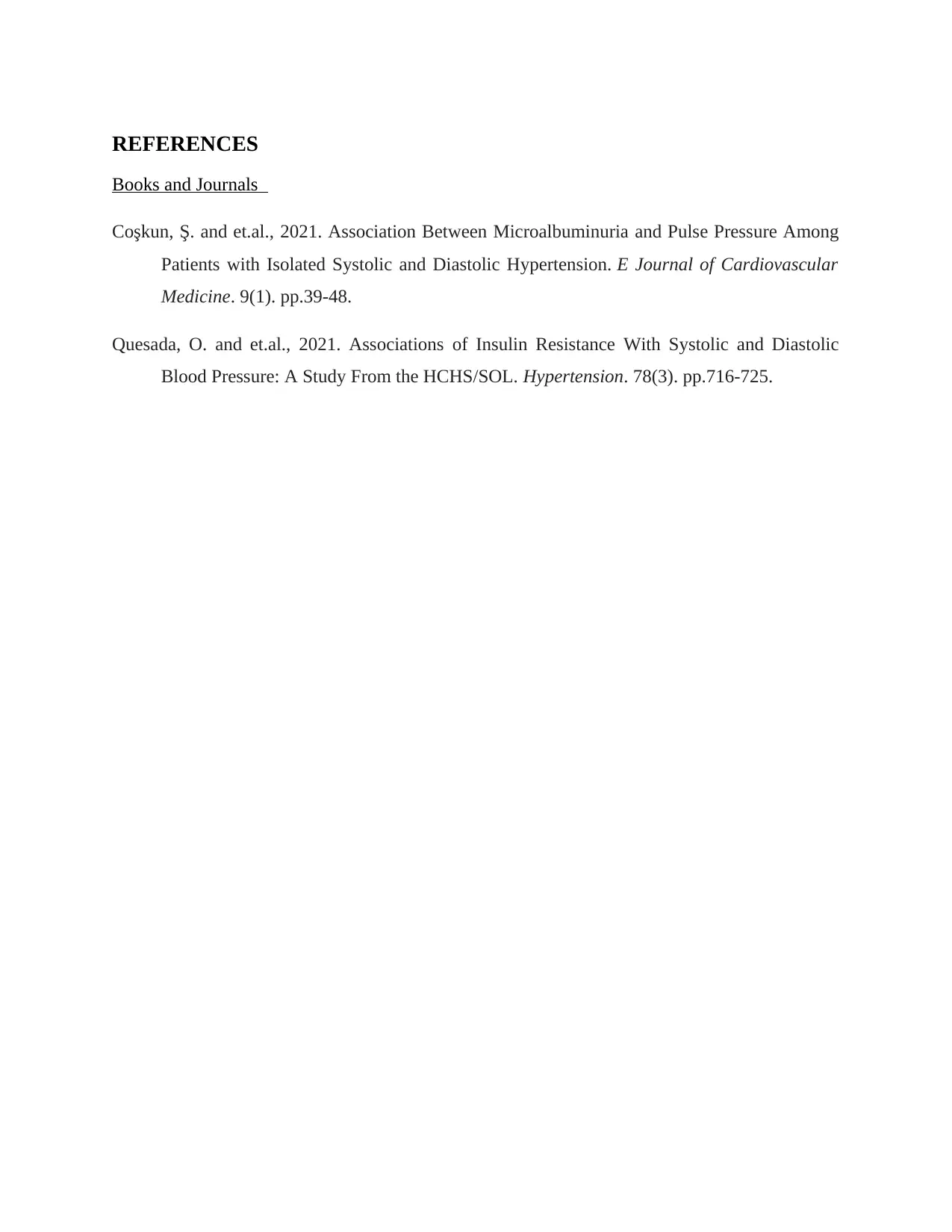
REFERENCES
Books and Journals
Coşkun, Ş. and et.al., 2021. Association Between Microalbuminuria and Pulse Pressure Among
Patients with Isolated Systolic and Diastolic Hypertension. E Journal of Cardiovascular
Medicine. 9(1). pp.39-48.
Quesada, O. and et.al., 2021. Associations of Insulin Resistance With Systolic and Diastolic
Blood Pressure: A Study From the HCHS/SOL. Hypertension. 78(3). pp.716-725.
Books and Journals
Coşkun, Ş. and et.al., 2021. Association Between Microalbuminuria and Pulse Pressure Among
Patients with Isolated Systolic and Diastolic Hypertension. E Journal of Cardiovascular
Medicine. 9(1). pp.39-48.
Quesada, O. and et.al., 2021. Associations of Insulin Resistance With Systolic and Diastolic
Blood Pressure: A Study From the HCHS/SOL. Hypertension. 78(3). pp.716-725.
1 out of 10
Your All-in-One AI-Powered Toolkit for Academic Success.
+13062052269
info@desklib.com
Available 24*7 on WhatsApp / Email
![[object Object]](/_next/static/media/star-bottom.7253800d.svg)
Unlock your academic potential
Copyright © 2020–2025 A2Z Services. All Rights Reserved. Developed and managed by ZUCOL.